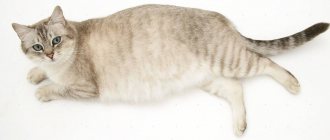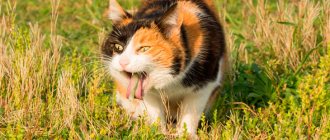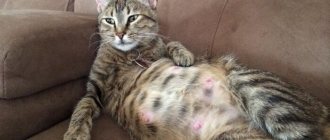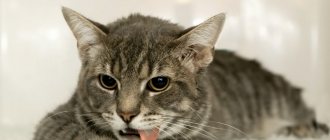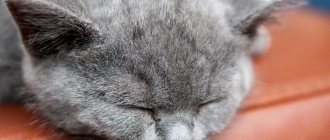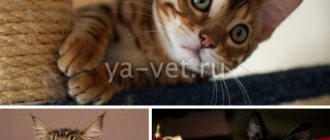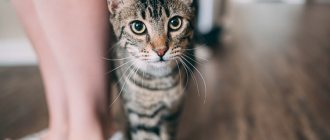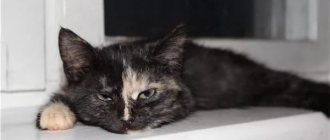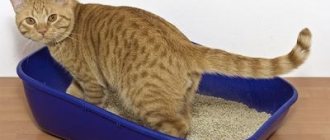11424Administration
4
Vomit with green discharge indicates that a large amount of bile and intestinal secretions have accumulated in the stomach. This is the so-called cleansing vomiting, which helps rid the body of excess. But green vomit in a cat can be a harbinger of a dangerous infection.
You can determine the risks for your pet by studying the causes that influence the occurrence of nausea.
© shutterstock
The following factors can lead to green vomit and cause nausea::
- Infection . Poor quality food or expired products often cause dangerous infections in the body. Therefore, most street cats suffer from weight loss: parasites destroy a weakened body.
- Poisoning . A cat can become poisoned from food or medications. Bile mass is the body’s reaction to toxins and other harmful substances that the stomach throws out through nausea.
- Intestinal problems . The problem is more difficult if vomiting does not stop for a long time. This may be a sign of a blockage in the intestinal tract. Therefore, if there is active nausea with green discharge, foam and blood, it is better to show it to a veterinarian.
- Diseases . Cats suffer from chronic illnesses. These are problems with the bladder, ulcers, cancerous tumors. For a sick animal, yellow vomit is a common practice. If there are brown spots, the result is almost one hundred percent - an ulcer.
Types of vomiting in cats
Sporadic vomiting in a cat can occur with liver disease, kidney disease, diabetes mellitus, worms, chronic gastritis, and irritable bowel syndrome.
Persistent vomiting in cats occurs due to injuries, when the cat eats grass, hairballs or foreign objects, or infectious enteritis.
In the case where there is blood in the vomit, such vomiting usually occurs when a foreign object is swallowed, causing injury to the mucous membrane of the esophagus and stomach. If the owner of the cat detects blood in the vomit of the cat in the form of “coffee grounds,” this indicates bleeding in the stomach or in the upper parts of the small intestine. If there is an unpleasant foul odor from the vomit, it is necessary to exclude intestinal blockage or peritonitis. Sometimes such vomiting in a cat occurs as a result of blunt trauma to the abdomen.
What treatment is needed?
Often, simple vomiting in a kitten or young adult can be dealt with at home. If the discharge is profuse and causes you doubts, then do not delay going to the veterinarian. You should also see a doctor if your cat has vomited more than twice.
The first thing to do if your pet’s condition noticeably deteriorates is to prevent dehydration. To do this, offer your cat clean water every hour.
If there is a suspicion of ingestion of a foreign object, then you can independently examine the mouth and throat. Often hairballs or large pieces of food get stuck at the very top. In this case, it is not difficult to remove them yourself
After such a procedure, it is important to give the body a rest. Do not feed or water the animal for at least 12 hours; ice cubes will help quench thirst
Didn't he feel sick during the day? Try giving baby meat puree in small portions, 5-6 times a day. The diet must be followed for up to three days, then you can move on to your normal diet.
Sometimes it happens when an animal feels bad, but cannot vomit on its own. Then you can induce vomiting in one of the following ways:
- Give your cat a glass of slightly warm water, in which you must first dissolve a tablespoon of salt. It is necessary for the pet to drink quickly and in large sips.
- Place the cat on its side and lightly press the root of the tongue with a clean index finger.
!!! It is forbidden to induce vomiting if the animal has swallowed a sharp object. This can cause serious irritation of the esophagus.
There are several types of vomit in cats.
Vomit with hairballs.
This type of vomiting in cats is considered to be a normal process from a physiological point of view, which occurs in cats 1-2 times a month. Cats in a similar way free their stomachs from the fibers of their fur that have fallen during the process of licking. Such hairballs that have entered the stomach can be removed from the cat's stomach with the cat's feces. Sometimes such lumps in a cat can cause obstruction of the gastrointestinal tract.
Vomiting of whole, almost undigested food.
This type of vomiting in a cat occurs 15-30 minutes after the cat has finished eating. This vomiting occurs in a cat when it has previously been hungry and the animal is forced to eat a large amount of food due to hunger. It happens when, after eating, a cat is forced to engage in active games, jumping, when the food eaten is not able to be absorbed.
Vomit mixed with bile.
Bile is normally located in the gallbladder of a cat and should not normally be contained in vomit from the stomach. The appearance of bile tells its owner about diseases of the gallbladder or liver. When a cat's vomiting is prolonged, then after the contents of the stomach are released, bile begins to be released when the cat vomits. Bile entering the stomach causes inflammation of the gastric mucosa.
Vomiting liquid or foam.
This type of vomiting is preceded by 4-8 reflex muscle contractions of the abdomen. At the same time, the cat tenses and experiences discomfort. When a cat vomits, it stops licking itself, tends to hide in a secluded place and does not pay any attention to others. Sometimes it happens that despite an intense urge to vomit, it is not observed. However, this causes pain in the cat. At the same time, the cat refuses the food and water offered to it, due to the fact that they cause it to constantly vomit, the cat constantly licks its lips.
Vomit mixed with blood.
Individual inclusions of scarlet color in the vomit indicate mechanical damage to the digestive organs. These injuries most often occur in cats when they swallow foreign objects with sharp edges (meat and fish bones).
A rich red color indicates damage to the lower parts of the digestive system. This vomit may be the result of bleeding in the stomach, where the blood reacts chemically with gastric juice. This kind of vomit in cats occurs due to gastritis, malignant neoplasms, and also sharp objects that have entered the stomach.
Green vomit.
Green vomit in a cat occurs with diseases of the liver, gall bladder or intestinal obstruction. With these diseases, there is a large secretion of bile or when the contents of the intestines are thrown into the stomach. Vomiting of green matter in a cat occurs as a result of the cat consuming fresh or dry grass.
The presence of feces in the vomit.
The appearance of feces in a cat’s vomit indicates an intestinal blockage, an injury to the abdominal area, or the presence of peritonitis.
How to feed correctly?
A pet will not drink vitamins if they are lacking, so all the vitamins and minerals it needs must be present in the food. The animal needs balanced food. How to feed your furry friend correctly, how to make sure that the animal receives with food everything it needs for proper development and good health?
- First, the amount of food should be limited. You need to feed the animal 2-3 times, in the morning and in the evening, but you can skip lunch. Portions should be approximately the same size each time. It is better to put in less food and then add it later, rather than the animal overeating and becoming ill.
- Secondly, the food must be of high quality. High quality does not mean expensive. You can boil the animal’s meat yourself, adding carrots and other vegetables. If you don’t want to cook separately for your cat, then you should contact your veterinarian for advice; he will be able to tell you exactly what food is suitable for a particular breed.
- Thirdly, the water in the bowl must be clean. You need to change and add water at least twice a day, it is better to do this in the morning and evening. Your furry friend should always have water. There is no need to experiment and pour mineral water with gases into your cat. The cat will not drink water, and he will have to sit without water all day, which is fraught with negative consequences for his body.
- Fourthly, a four-legged friend needs grass. You can buy seeds for such grass at any pet store; it is inexpensive, grows quickly, and looks like a lawn. Cats love this simple green grass.
- Fifthly, your pet’s diet must include fish. Fish contains useful microelements that a cat needs as a predator.
- Sixth, if a favorite predator eats what its owner eats (some cats love apples, cucumbers and other foods), there is no need to wean him off. This means that the beneficial substances contained in these products are necessary for the predator.
Creating the right diet for a cat is not difficult. The main thing is to monitor your pet’s well-being, carefully read the composition of the food he eats, listen to the veterinarian’s recommendations and add variety to your pet’s diet.
Vomiting in a cat is a fairly common phenomenon. Periodically, our pets cleanse their stomachs in this way and get rid of discomfort. But sometimes it can be a clear sign of something wrong with the body, such as when your cat vomits yellow liquid. Every loving owner should learn to distinguish a natural urge from one caused by a disease. In most cases, with adequate assistance, the illness goes away quickly and without any consequences.
What diagnostic measures are carried out in a veterinary clinic?
When a cat is admitted, the veterinarian conducts a full clinical examination. During which the general condition of the cat’s body, coat, is assessed, body temperature is measured, and auscultation of the respiratory organs and heart is performed. Palpation of the abdominal area determines the tone of the abdominal muscles and determines the presence of certain foreign formations. To correctly judge the cat’s health, specialists must conduct a general and biochemical blood test, a blood test for the presence of parasites, pathogens of infectious diseases, a general urinalysis, a stool test for helminths, an ultrasound of the abdominal organs, and an ECG.
What diseases can there be?
Based on the symptoms, the veterinarian will be able to determine what the pet is sick with and prescribe the necessary treatment. Diseases that cause vomiting after eating include:
- Gastritis;
- Ulcer;
- Colitis;
- Pancreatitis;
- Intestinal pathologies (tumors, obstruction, unstable blood supply);
- Helminths.
To determine more precisely, it will be necessary to do an ultrasound of the gastrointestinal tract and undergo tests. After this, the veterinarian will be able to tell exactly what’s wrong with the pet and prescribe medications. There is no need to treat a cat yourself after learning his diagnosis; human medicines will not suit him, but, on the contrary, will ruin the body. If the doctor said that there are no threats and the pet is healthy, then you just need to reduce portions, drink more water and eat special grass. The cat needs grass to help its digestive system rest from food and cleanse itself.
First aid
To alleviate some of the general condition of your cat, you need to stop feeding it for a day; you can leave free access to water, but only if the water does not cause new vomiting.
In the case when the cat vomited once and the cat feels normal after that, then the owner is not required to carry out treatment.
If a cat vomits more than three times a day, as a result of which the cat becomes depressed and painful, then after visiting a veterinary clinic, the cat is put on a special diet and food is limited. To prevent dehydration, the cat is prescribed Regidron solution or saline solution. If the cat refuses water, Ringer's solution is injected subcutaneously.
Treatment of vomiting should be aimed at eliminating the underlying cause of the cat's vomiting.
If the gastrointestinal tract is blocked by wool, pieces of wool are removed with a special probe. A conservative method of removing hair is to give it food with a high fiber content or prescribe drugs that cause rapid evacuation of hair from the stomach - Malt paste. Surgery is performed to remove hairballs.
The cat is given phenothiazine, torecon, and passertin as an antiemetic. If a cat's vomiting is caused by poisoning, it is prescribed internally with activated carbon (1 tablet per 10 kg of body weight), smecta, enterosgel and other adsorbent substances. To speed up the elimination of poisons that have entered the body, diuretics are prescribed.
In a veterinary clinic, to relieve intoxication, the cat is prescribed droppers with a solution of glucose and ascorbic acid.
For infectious diseases, a course of antibiotics is administered.
When vomiting caused by worms, deworming is carried out first.
What to do if your cat vomits from any food?
The first cause of vomiting in a furry friend is unsuitable food. This rarely happens; usually the animal itself refuses to eat this or that food. By smell, these domestic predators determine whether the food is of low quality and whether what is in the bowl is worth eating. If the owner has already tried all the food, but the situation has not changed, then the problem is not in the food. There are two options: the animal simply overate, or got sick. The first option is easier to deal with
To prevent the animal from overeating, it is important to feed a strictly defined amount of food, without exceeding the volume
Animals have almost no feeling of satiety. Cats are no exception; they will eat until their bowl is empty, and then vomit up undigested food and cover it with a rug. If your cat gets sick after eating food, you just need to give her more water and reduce the portion.
As for the second option – disease, things are more complicated. Simply reducing portions will not correct the situation. It is better not to diagnose the animal’s condition yourself, but to consult a veterinarian.
Preventing vomiting in cats
Prevention of vomiting in cats should be based on feeding fresh, good-quality food or purchased commercially produced food. Avoid feeding your cat raw fish and meat. Your cat must be vaccinated against infectious diseases common in your region. In order to prevent helminthic diseases, it must be treated for worms twice a year. If you keep cats of long-haired breeds, it must be brushed regularly so that its gastrointestinal tract does not become clogged with hair. In order to monitor its health, the cat must be periodically shown to the clinic’s veterinarian.
What to feed after vomiting?
In addition to treatment, the cat’s nutrition during this period is also important. The menu must be dietary, and constant monitoring of the well-being of your four-legged friend must be ensured. When yellow vomiting is observed in an animal, the cat should be hungry for the first 10 hours, and instead of drinking, you can give a piece of ice.
Constant nausea can lead to dehydration, so it is extremely important to monitor your pet's water balance. A therapeutic cat diet should not include fatty, salty and spicy foods. It is best to cook light porridges. If the cat is accustomed to dry food, then you need to change it to medicated food. For the first few days it is best to give:
- baby purees;
- rice broth;
- boiled chicken.
Rice decoction is beneficial for an animal after severe vomiting
Vomiting, its causes and dangers
Vomiting is a complex protective process based on reflexes, with the help of which the cat’s body gets rid of dangerous and harmful substances. Vomiting is usually the main symptom of gastrointestinal problems.
Let us immediately note that an attack of vomiting, occurring once every 3-4 days, is the norm, especially in cats. However, there are still specific reasons. To understand them, you need to analyze the cat’s diet, and perhaps make it starve for a while. Most often, cats vomit from overeating - they simply eat too much and too quickly. This applies to both dry food and natural food, but dry pieces are very easy to regurgitate, especially if they are poorly chewed. Most often, those animals that regurgitate are those that live in conditions of competition for food and therefore absorb food quickly and greedily. By the way, some of them will not disdain to eat the food removed from the body again.
Animals that live together tend to eat quickly and chew their food poorly, so regurgitation is common for them.
If a domestic cat often regurgitates food as soon as it leaves its bowl, then it is overeating or this type of food is of poor quality. Economy-class food, such as Felix, Whiskas, Sheba and the like, have a poor composition and contain many harmful additives, so such food will clearly not benefit your pet.
It is advisable to purchase premium and super-premium food for your pet, and for chronic diseases - specialized lines of such food
Causes of vomiting in cats
The main causes of vomiting can be divided into two large groups: reflex irritation of the digestive organs and poisoning.
In the first case, foreign substances or excessive amounts of food irritate the organs of the digestive tract and cause a reflex reaction of rejection. The following reasons may lead to this:
- improper diet: too rich, not suitable for cats, poor consistency (sticky, rubbery food, with bones, etc.);
- ingestion of a large amount of hair when licking (especially in long-haired cats): hairballs cause mechanical irritation of the stomach and also interfere with the normal excretion of feces from the body, which also contributes to vomiting;
- parasites that mechanically irritate the liver and intestines;
- chronic diseases of the gastrointestinal tract;
- ingestion of foreign bodies - small toys, hair bands, threads, waste from a garbage can;
- seasickness - vomiting due to disturbances in the functioning of the vestibular apparatus.
In the second case, poisoning occurs with toxic substances that enter the blood, spread throughout the body, irritate the vomiting center in the brain and cause vomiting. Intoxication may have the following origins:
- waste products of intestinal parasites - kittens are especially sensitive to their effects;
- poor quality, expired food;
- chemicals: detergents, bleach, medications, indoor plants;
- infectious and inflammatory diseases leading to disorders of the gastrointestinal tract;
- chronic kidney diseases, causing general intoxication of the body;
- false pregnancy, which can occur in cats after estrus;
- brain damage: trauma, edema, increased intracranial pressure;
- stress, shock or psychological trauma.
Danger of vomiting
A dangerous consequence of vomiting is dehydration, which quickly occurs with persistent and prolonged vomiting. It is especially poorly tolerated by small kittens. An animal can quickly die from dehydration, so if vomiting does not stop, you should immediately take the animal to a doctor.
With persistent vomiting, even water is not retained in the cat’s body: as soon as the cat drinks, it starts vomiting again
It is also necessary to measure the cat’s temperature: in case of infectious and inflammatory diseases it increases, in case of poisoning and shock it decreases. In both cases, you need to go to the doctor or call him at home.
The temperature in cats is measured in the anus for 2-3 minutes, the norm is a temperature of 38 to 39 degrees
The vomit should not contain blood, mucus, have a strange color or a foul odor - in this case, you should also contact your veterinarian immediately.
Symptoms of vomiting
Many owners confuse the symptoms of vomiting with coughing, thinking that their pet vomited due to a severe cough. But it is cough that is a symptom of vomiting, and not vice versa. A normal attack of vomiting has several stages:
- The cat feels nauseous, shows anxiety, moves from place to place, licks itself, makes swallowing movements, and salivates profusely.
- The animal begins to cough, stretches its head forward, and breathes deeply and frequently.
- Contractions occur in the abdomen and throat, vomiting occurs, often at first sterile, and then with contents.
At first the cat feels nauseous, gets restless and licks its lips, and an attentive owner may already notice at this stage that the pet will soon vomit

